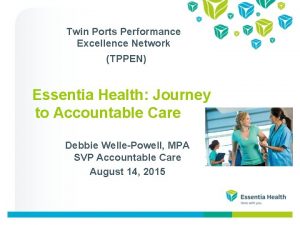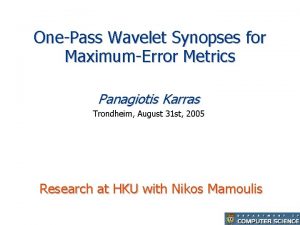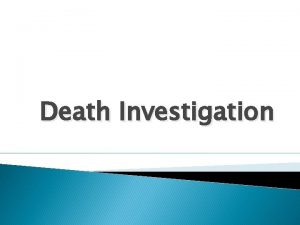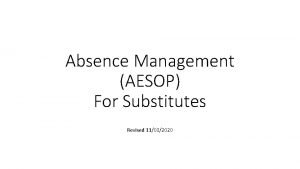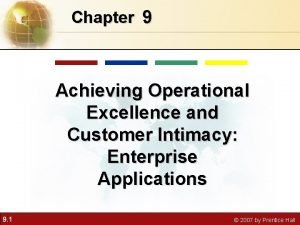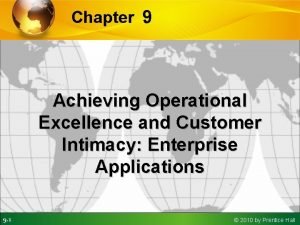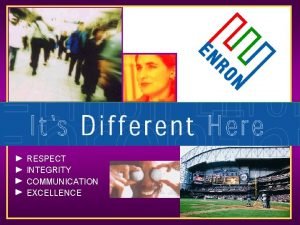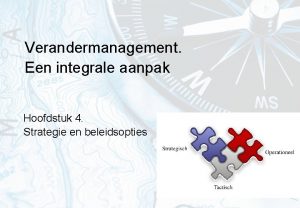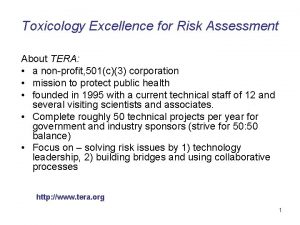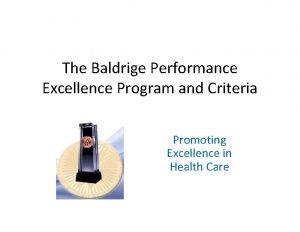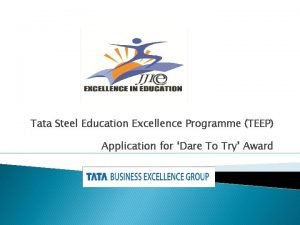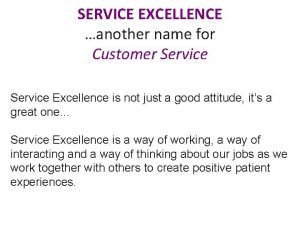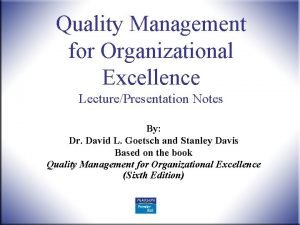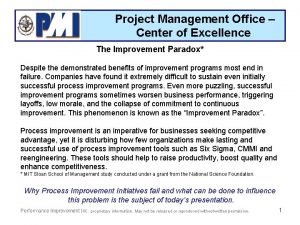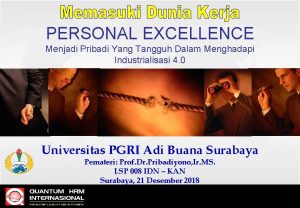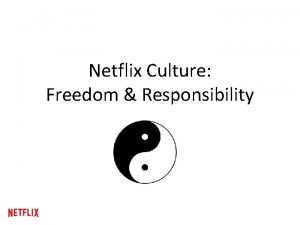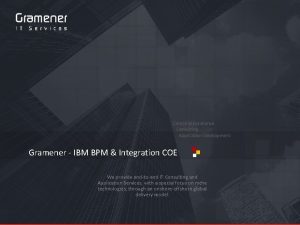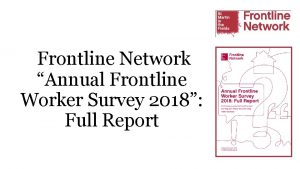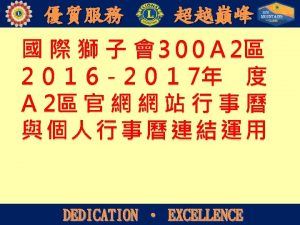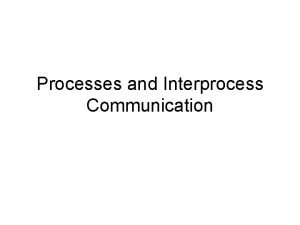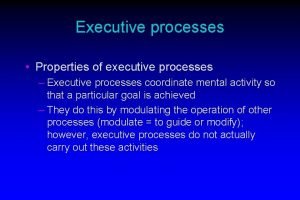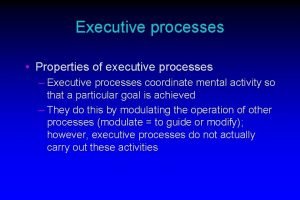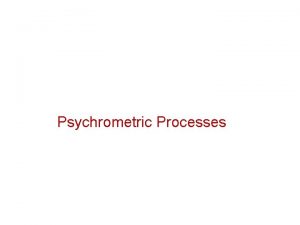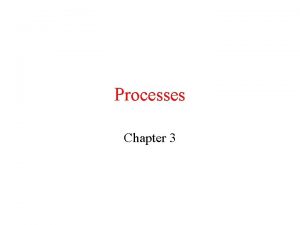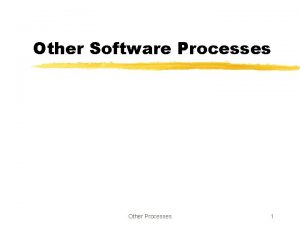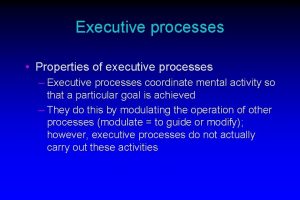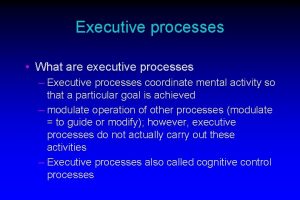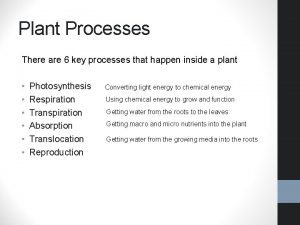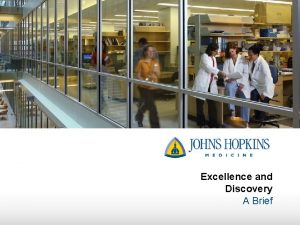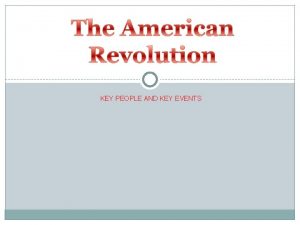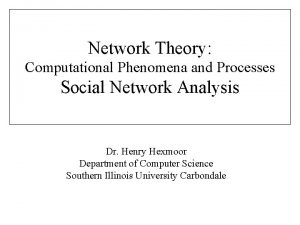Frontline Excellence and Superior Network Processes as Key






















































- Slides: 54

Front-line Excellence and Superior Network Processes as Key levers to Increase Value for a Telco Pedro de Boeck-BL, Peter Slagt-BL, Amine Tazi-Riffi-GN, Rickard Asp-SK, Johan Wahlström-SK, Worldwide Telecom Conference Toronto, June 22 -23, 1998

KEY MESSAGES Frontline excellence and superior network processes are key levers to increase value for a Telco. This additional value can be created through a proper Capex reduction program and by a tailored process and individual performance improvement program in I&M • A proper Capex optimization program can reduce network related investments by 10 to 35% without jeopardizing service quality or innovation. It might also help indirectly improve I&M costs through reduction of “construction” activities • General process improvements in Call Centres and Dispatch Centres can improve customer satisfaction and enhance productivity in I&M by 10 to 15%. Individual performance improvement of front-line technicians can improve productivity by an additional 10 to 20%

VALUE CREATION FOR INCUMBENT TELCOS Percent of current value Included in current value: • Expected growth for fixed and mobile • Price setting as monopolist 100 Current value EU CLIENT EXAMPLE

VALUE CREATION FOR INCUMBENT TELCOS Percent of current value • Price decrease due to low cost attackers • Market share loss • Non active regulatory management 100 50 -70 Net value destruction Current value EU CLIENT EXAMPLE

VALUE CREATION FOR INCUMBENT TELCOS Percent of current value, 3 years perspective EU CLIENT EXAMPLE • CAPEX reduction • OPEX reduction 150– 210 10– 40 40 -70 100 50 -70 30 -50 15– 20 10 -20 Additional Improved growth customer service M&A Productivity Net value Regulatory destruction mgmt Current value New potential value

KEY LEVERS FOR IMPROVING CASH FLOWS 100 25– 30 60– 65 CAPEX 5– 15 OPEX Revenues Net cash flow

KEY LEVERS FOR IMPROVING CASH FLOWS 100 25– 30 80% Reduction potential: 10 -35% of Network Capex 60– 65 CAPEX 5– 15 OPEX Revenues Net cash flow

KEY LEVERS FOR IMPROVING CASH FLOWS 100 25– 30 80% Network Capex 60– 65 CAPEX Personnel cost 35 I&M personnel related cost 60% 5– 15 OPEX Revenues Net cash flow Reduction potential via • Process reengineering: 10 -15% • Frontline performance improvement: 10 -20%

KEY MESSAGES Frontline excellence and superior network processes are key levers to increase value for a Telco. This additional value can be created through a proper Capex reduction program and by a tailored process and individual performance improvement program in I&M • A proper Capex optimization program can reduce network related investments by 10 to 35% without jeopardizing service quality or innovation. It might also help indirectly improve I&M costs through reduction of “construction” activities • General process improvements in Call Centres and Dispatch Centres can improve customer satisfaction and enhance productivity in I&M by 10 to 15%. Individual performance improvement of front-line technicians can improve productivity by an additional 10 to 20%

CENTRAL ROLE OF CAPEX FOR TELCOS 1. Cost position • 20 -30% of cash flows • Moreover: driver of key labour-intensive processes Capital expenditures 3. Service delivery • Significant potential impact on service levels • Tight links with front-line core processes 2. Product strategy/innovation • Fundamental role of innovation for future competitive position • Technological “bets”

S-CURVE ON CAPEX EFFICIENCY Capex efficiency Best practice Capex productivity Traditional incumbent Telco Time

RECENT Mc. KINSEY ENGAGEMENTS Reduction as % of current CAPEX Capex efficiency Best practice Capex productivity Leapfrog Recent engagements (in continental Europe) • Telco 1: 30– 35% • Telco 2: 30% • Telco 3: 25– 30% Traditional incumbent Telco Time

RECENT Mc. KINSEY ENGAGEMENTS Reduction as % of current CAPEX Capex efficiency Best practice Capex productivity Sustainable improvemen t Recent engagements • Telco 4: 15– 20% • Telco 5: 10– 15% Traditional incumbent Telco Time

THE S-CURVE ON CAPEX OPPORTUNITIES Capex efficiency Telco still facing Capex productivity program • Overall methodology and integrated approach to leapfrog to best practice while minimizing market risks • Strong focus on bottom-up approaches Telcos having already undergone a Capex productivity program • Diagnostic tool to assess whether best practice achieved • Possibly new, bottom-up ideas for further potential • Approach for sustainable impact, taking into account trade-offs vs. OPEX and quality level Possible Capex reductions 20 - 40% 10 - 20%

VERY DIFFERENT APPROACHES AND LEVERS DEPENDING ON THE INVESTMENT CATEGORY 2/3 1/3 Recurrent investments • Renewal of network • Extension of network Non-recurrent investments • Modernization / technology shift • New services / functions • Innovations Total network investments

VERY DIFFERENT APPROACHES AND LEVERS DEPENDING ON THE INVESTMENT CATEGORY 2/3 Recurrent investments • Renewal of network • Extension of network 1/3 Total network investments Description • Asset renewal/replacement and incremental growth • Thousands of small projects, with highly decentralized decisions by hundreds of planners project engineers • Examples: line cards, access network (cable, canalization), etc. Thrusts/Approach • Differentiated planning guidelines according to attractiveness of access networks (ABC) • Differentiated controlling structure • Ultimately: differentiated target reserve levels and service quality

THRUSTS / LEVERS FOR RECURRENT INVESTMENTS Very demanding budgeting targets • Large investment block • Competition for innovation ressources High complexity in the access network • Large number of projects • Very diverse situations • Case-by-case controlling unrealistic Classification of access networks B A C A A B Differentiated investment policy • Reduction of market risk in A areas • Differentiated catalogue of measures and operational targets Differentiated ressource allocation B B B C C Differentiated controlling • Stricter controlling on C areas • Flexibility in application ("management by exception")

COMPLEX DECISION MAKING IN FRONT-LINE UNITS Low threshold High threshold Situation • Cooperation opportunity with a Utility company • Pre-investment of 50 K required • 50% cost saving vs. normal case, yet no direct customer needs Traditional Telco Best Practice Telco Forecasted capacity surplus • Go decision • No reward for risk taking • Telco X: 25 % of investment in access No risk decision -10% 0% +10% A areas B areas Calibrated investment decision

ABC CLASSIFICATION OF ACCESS NETWORKS AS KEY INSTRUMENT DISGUISED EXAMPLE Growth (CAGR 1998– 2002), return (ROI), percent Growth A C B Return

APPROACHES AND DETAILED MEASURES FOR RECURRENT INVESTMENTS LINES DISGUISED EXAMPLE Approach Measure Application L 1. 1 Severe reduction of preinvestments based on L 1: Reduction formal assessment of of pre-investment economic risk/return • 'Go/No-go' decision • Capacity planning • According to cash-flow-based L 3. 1 Avoidance of construction work through systematic use L 3: Use of transmission equipment in case of bottleneck Savings Feasipotential (Pilot in Mio$) bility Priority 60 -70 1 • Systematic examination. Possible restriction on the services (e. g. , ISDN not possible anymore); A/B/C-differentiation 5 -10 1 L 3. 2 Avoidance of construction work through use of ISDN (BA) for • Second connection • Bottleneck for independent customer • A/B/C: Systematic examination. Possible restriction on the services (e. g. , ISDN not possible anymore) 0 -2 2 L 3. 3 Use of a PA to a PBX instead of new access lines • ABC: In case of bottleneck to a customer, proactively try to sell PA solution (possibly: tied with incentives for the customer) 0 -2 2 assessment of econonic return • ABC: differentiated parameters, in C areas more restrictive reductions than in A-areas

BOTTOM-UP "SNOWBALL" EFFECT TO LAUNCH PROCESS Budget cut 1 to 2 quarters 2 -3 months 1 -2 months Local case study Objectives • Customized approaches • Build up motivated core team Client people involved 10 Pilot in selected region • Catalogue of measures / investment manual 20 -40 Roll-out • Leverage snowball effect 700 -800

BOTTOM-UP "SNOWBALL" EFFECT TO LAUNCH PROCESS 2 -3 months Budget 1 to 2 quarters cut 1 -2 months Local case study Pilot in selected region Roll-out Impact on personnel Impact on investment level 45 -50% Achieved impact 35 -40% 30 -35% Planning & projects 15 -25% Construction A area B area C area Total 25 -30%

BOTTOM-UP "SNOWBALL" EFFECT TO LAUNCH PROCESS 2 -3 months Budget 1 to 2 quarters cut 1 -2 months Local case study Pilot in selected region Roll-out • Front-line bottom-up focus with motivated core team Key success factors • Tailoring to local technology and regulatory constraints • Strong commitment/availability of top management and coordinated budget cut • Over-investment in roll-out plan (training, dedicated controlling, etc. )

VERY DIFFERENT APPROACHES AND LEVERS DEPENDING ON THE INVESTMENT CATEGORY Description • Go/no Go decisions about introduction or development of platforms • Strategy driven decisions, often centrally taken • Examples: digitalization, platform upgrades SDH, ATM, etc. 2/3 1/3 Non-recurrent investments • Modernization / technology shift • New services / functions • Innovations Total investments Thrusts/Approach • Focus on skills building and process with "checks and balances" • "Investment Office" to review top Capex decisions. Key levers per program: – Timing – Full area coverage – Synergies/impact on other platforms

APPROACH FOR NON RECURRENT INVESTMENT Budget cut Investment Office Set-up criteria “Screening“ • Plausibility evaluation • Dialogue for optimization Business case • Leadby promoting unit • Clear criteria and procedures Resource allocation Controlling

KEY INSIGHTS FROM CONCRETE INVESTMENT PROGRAM REVIEWS Possible pitfalls • “Market requirement” sometimes taken as a “fixed point” without critical evaluation/calibration and quantification (from overall Telco perspective) of effective consequences • Mismatch of investment to the sales/growth figures in Service Level Agreements (clear goals defined and accepted by the sales unit) • Business cases and deployment plans undifferentiated by geographical areas (full area coverage, not prioritized) • Significant investment in potentially “interim platforms” with unclear future • Systematic realization with new material

KEY MESSAGE Frontline excellence and superior network processes are key levers to increase value for a Telco. This additional value can be created through a proper Capex reduction program and by a tailored process and individual performance improvement program in I&M • A proper Capex optimization program can reduce network related investments by 10 to 35% without jeopardizing service quality or innovation. It might also help indirectly improve I&M costs through reduction of “construction” activities • General process improvements in Call Centres and Dispatch Centres can improve customer satisfaction and enhance productivity in I&M by 10 to 15%. Individual performance improvement of front-line technicians can improve productivity by an additional 10 to 20%

PRODUCTIVITY IMPROVEMENT OPPORTUNITIES IN THE PRIMARY PROCESS OF I&M Customer Request Sales Office Wo ord rk er Dispatch Centre Fieldwork Work order Call Centre installation/ Call Centre repair rk Wo er ord Overall process improvement Reduce dispatch volume Improve workorder dispatching I&M productivity improvement opportunities Improve individual performance

PRODUCTIVITY IMPROVEMENT OPPORTUNITIES IN THE PRIMARY PROCESS OF I&M • Improve network preventive maintenance Reduce dispatch volume Improve workorder dispatching I&M productivity improvement opportunities Improve individual performance

PRODUCTIVITY IMPROVEMENT OPPORTUNITIES IN THE PRIMARY PROCESS OF I&M • Improve network preventive maintenance • Improve upstream call screening and diagnosis of situation Reduce dispatch volume Improve workorder dispatching I&M productivity improvement opportunities Improve individual performance

PRODUCTIVITY IMPROVEMENT OPPORTUNITIES IN THE PRIMARY PROCESS OF I&M • Improve network preventive maintenance • Improve upstream call screening and diagnosis of situation Reduce dispatch volume • Improve load management and crew scheduling • Improve dispatch methodology and tools • Improve communication flows between players Improve workorder dispatching I&M productivity improvement opportunities Improve individual performance

PRODUCTIVITY IMPROVEMENT OPPORTUNITIES IN THE PRIMARY PROCESS OF I&M • Improve network preventive maintenance • Improve upstream call screening and diagnosis of situation Reduce dispatch volume • Improve load • Define and collect management and crew scheduling • Improve dispatch methodology and tools • Improve communication flows between players individual performance data • Link coaching to individual performance results • Ensure continuous improvements Improve workorder dispatching I&M productivity improvement opportunities Improve individual performance

IMPROVE PROCESSES IN THE CALL CENTRE Example repair • Organization • Tools “Centralized Call Centres” • Centralized operators for repair • Minimized entry points • Basic tool to diagnose the technical situation Potential impact • Field productivity improvement for repair technicians • Customer satisfaction improvement “Specialized operators with second support line” “World class diagnostic tools”

IMPROVE PROCESSES IN THE CALL CENTRE Example repair • Organization • Tools “Centralized Call Centres” • Centralized operators for repair • Minimized entry points • Basic tool to • Specialized operators by customer segment and second support line for complex problems • Additional voice diagnose the technical situation Potential impact “Specialized operators with second support line” responsive unit to automatically route to the right operator by customer segment • Field productivity improvement for repair technicians • Customer satisfaction improvement 5 -10% Medium “World class diagnostic tools”

IMPROVE PROCESSES IN THE CALL CENTRE Example repair • Organization • Tools “Centralized Call Centres” • Centralized operators for repair • Minimized entry points • Basic tool to • Specialized • Higher skilled operators by customer segment and second support line for complex problems operators • Additional voice diagnose the technical situation Potential impact “Specialized operators with second support line” “World class diagnostic tools” • Last generation responsive unit to automatically route to the right operator by customer segment diagnostic tools • Field productivity improvement for repair technicians • Customer satisfaction improvement 5 -10% Medium

IMPROVE PROCESSES IN DISPATCHING FUNCTIONS Integrated automated central dispatch Centralized manual dispatch Manual dispatching within the section Organization • Dispatching done in the section • Experienced dispatchers Tools • No specific tool; Manual dispatching in the section Potential • Field and dispatching impact productivity • Customer satisfaction improvement

IMPROVE PROCESSES IN DISPATCHING FUNCTIONS Integrated automated central dispatch Centralized manual dispatch Manual dispatching within the section Organization • Dispatching done in the section • Experienced dispatchers Tools • No specific tool; Manual dispatching in the section • Manual dispatching centralized per region • Manual dispatching rules • Skill matrix of technicians • Location-matrix • Prioritization rules by customer segment Potential • Field and impact dispatching productivity • Customer satisfaction improvement • 0 -5% • Medium

IMPROVE PROCESSES IN DISPATCHING FUNCTIONS Integrated automated central dispatch Centralized manual dispatch Manual dispatching within the section Organization • Dispatching done in the section • Experienced dispatchers Tools • No specific tool; Manual dispatching in the section • Manual dispatching • Region cross-border centralized per region and cross-function automated dispatching • Skill matrix of technicians • Dispatching system to • Location-matrix optimize a dispatch • Prioritization rules by routine segment • Technician handset and printer to receive orders Potential • Field and impact dispatching productivity • Customer satisfaction improvement • 0 -5% • 5 -10% • Medium • High

THE TELCO UNIVERSE IN I&M PROCESS Increased productivity Call Centre process 300 “World class“ diagnostic tools American 2 American 1 250 “Specialized operators“ with second support line “Centralized Call Centre“ # access lines/ employee European 4 European 2 200 European 1 European 3 Emerging markets Manual dispatch in the section Centralized manual dispatch Integrated automated central dispatch Dispatching process

PRODUCTIVITY IMPROVEMENT OPPORTUNITIES IN THE PRIMARY PROCESS OF I&M Reduce dispatch volume Improve workorder dispatching I&M productivity improvement opportunities Improve individual performance

INTERVIEW QUOTES “Do I have to improve my hours/dispatch or my repeat rate ? ” Technician “There is no production data available on the individual technician level” Supervisor “I have the longest hours/dispatch in the section, but I should not be penalized because I do the most difficult orders” Technician “The evaluation and individual coaching of a technician is based on qualitative assessments of the technician by the supervisor” District manager “Current training for technicians is very limited and not tailored to my specific needs” Technician

a ta d e nc a m rproduction o “There is no data f er p available al on the individual u d d technician level” ivi ar d c in De to improve my re Supervisor t o “Do I have c fin sc ll e o a hours/dispatchpor my repeat u cian C d er i i v hni fo rate ? ” d r in tec p Technicianman r o el pe ce v m De e as the longest hours/dispatch in “I have ur es but I should not be the section, penalized because I do the most difficult orders” Technician INTERVIEW QUOTES to “The evaluation and individual a t da g is based on coaching of a technician e nc chi n of the qualitative assessments a a osupervisor” rmthe c o technician by f l er dua p District manager k ivi n i L ind n “Current training fornitechnicians cia need is h ific cnot e very limited and to my t c e spetailored h t specificraneeds in he ir T nt Technician o d e bas

DEFINE OBJECTIVE PERFORMANCE MEASURE: THE PRODUCTIVITY SCORE Hours of work Number of work orders Number of completed work orders Number of work orders Hours per work order Speed Dispatch efficiency Hours per workorder weighted Dispatch efficiency * (1 - repeat rate) Efficiency Number of reopened work orders • Objective, simple, one score • Applicable within different Repeat rate Number of completed work orders Productivity = score Quality I&M-sections Hours Effective workorder

WEIGHTED PRODUCTIVITY SCORE EXAMPLE Weighted productivity score Non-weighted productivity score 150 • Weighting the 100 50 0 Ranking weighted score 1 2 3 4 5 6 7 8 9 10 11 12 13 Ranking nonweighted score 2 1 3 4 12 6 13 8 11 5 7 10 9 Agent spends 40% of his time on the activity with the longest duration Agent spends 75% of his time on the activity with the shortest duration productivity score enables : – Comparing agents with different activityportfolios – Comparing agent over a period of time – Setting uniform objectives

THE INDIVIDUAL PERFORMANCE MANAGEMENT APPROACH Individual performance measurement process Analysis Data collection Data storage and reporting • Collect • Store the data • Determine individual performance data using production data or individual measurement tools Individual coaching plan in a dedicated performance management database individual productivity scores • Develop reporting content and process Individual coaching and training process Training • Select appropriate training program to address specific individual needs Individual coaching • Supervisor to provide agent with individual score card and to discuss development plan Individual score card by agent by supervisor by District Manager by I&M director

DEVELOP INDIVIDUAL SCORE CARDS FOR AGENTS Administrative information • Agent: Serge Lebon • Supervisor: Pol Legrand • Tenure: 10 years • Function: electrician • Weighted productivity score ILLUSTRATIVE Working time Effective time = Ineffective time = Other = • Date: February 15, 1998 Last period results Last year results Period objectives Period results 2 h 21 2 h 31 2 h 01 2 h 35 60% 30% 100% Group Objectives average for next for period 1 h 50

DEVELOP INDIVIDUAL SCORE CARDS FOR AGENTS Administrative information • Agent: Serge Lebon • Supervisor: Pol Legrand • Tenure: 10 years • Function: electrician Working time Effective time = Ineffective time = Other = • Date: February 15, 1998 Last period results Last year results ILLUSTRATIVE Period objectives Period results 60% 30% 100% Group Objectives average for next for period • Weighted productivity score 2 h 21 2 h 31 2 h 01 2 h 35 1 h 50 – Hours per WO 1 h 24 1 h 30 1 h 12 1 h 24 1 h 09 – Dispatch efficiency 66% 70% 66% 62% – Repeat rate 10% 15% 10% 13% 5% 13% • Utilization 65% 70% 67% 75% 67%

DEVELOP INDIVIDUAL SCORE CARDS FOR AGENTS Administrative information • Agent: Serge Lebon • Supervisor: Pol Legrand • Tenure: 10 years • Function: electrician Working time Effective time = Ineffective time = Other = • Date: February 15, 1998 Last period results Last year results ILLUSTRATIVE Period objectives Period results 60% 30% 100% Group Objectives average for next for period • Weighted productivity score 2 h 21 2 h 31 2 h 01 2 h 35 1 h 50 – Hours per WO 1 h 24 1 h 30 1 h 12 1 h 24 1 h 09 – Dispatch efficiency 66% 70% 66% 62% – Repeat rate 10% 15% 10% 13% 5% 13% • Utilization 65% 70% 67% 75% 67% • Section level 80% 90% 85% 90% satisfaction sore Development plan • You are currently in the bottom 25% of the section. Pay attention and follow-up on your development plan. Pol will ride together with you each Tuesday from 9 h 00 - 11 h 00 • Advanced training ISDN-lines (next month) • Customer-satisfaction workshop (together with other section)

SET CLEAR PERFORMANCE STANDARDS AND INDIVIDUAL OBJECTIVES Weighted Productivity score Hours / effective task 1 h 14 0 First quarter Top performer Individua l objective setting • Consistent, rigorous 2 h 41 1 h 36 Second quarter 1 h 58 Third quarter Average Fourth quarter Minimum standard “Reach the top “Reach the performance in performance mean of the country” in the section” approach to minimum standards and individual objective settings • Credible, because based on actual performance variance of the section • Forces continuous improvement because entire distribution becomes “tighter” and moves positively over time • Gets away from top down undifferentiated approach with normative duration times

KEY LESSONS FOR A SMOOTH IMPLEMENTATION OF PRODUCTIVITY IMPROVEMENT PROGRAMS IN I&M • Create a bottom-up approach and buy-in from the field • Set-up top-down objectives from I&M directors to supervisors but let the supervisors fix individual objectives by technicians • Implement individual performance improvement program independently of the actual process in place at a Telco

KEY LESSONS FOR A SMOOTH IMPLEMENTATION OF PRODUCTIVITY IMPROVEMENT PROGRAMS IN I&M • Create a bottom-up approach and buy-in from the field • Set-up top-down objectives from I&M directors to supervisors but let the supervisors fix individual objectives by technicians • Implement individual performance improvement program independently of the actual process in place at a Telco • Involve unions along total program and be transparent on the content. • Prevent implementation of too many initiatives at the same time in the field • Leverage high quality client team in the roll-out phase

EXPERTS TO CONTACT FOR PERFORMANCE IMPROVEMENT PROGRAMS IN CAPEX AND I&M CAPEX improvement • Ameritech • Swiscom • Joe Nastassi • Greg Besio • Amine Tazi-Riffi • Andreas Tobler • Deutsche Telecom • Tony Bergmann • Jens Schulte-Bockum • Telefonica • Luis Benoliel • Telecom Finland • Harri-Pekka Kaukonen OPEX improvement • Ameritech • Greg Besio • Bell South • Mohan Giridharadas • Stu Flavin • Belgacom • Pedro de Boeck • Peter Slagt • Telia • Rickard Asp • Johan Wahlström

NEXT STEPS FOR THIS KNOWLEDGE BUILDING EFFORT • Design generic and specific diagnostic tools to quickly assess the potential opportunity at target clients • Develop “ready-to-use” one-hour presentations on each of the modules for discussions with client executives • Provide CST’s with start-up material for a one-day workshop at the start of engagement • Develop a LOP example for each module

 Frontline excellence
Frontline excellence Concurrent in os
Concurrent in os Performance excellence network
Performance excellence network Schoology login puyallup
Schoology login puyallup Frontline defense systems
Frontline defense systems Pbs frontline inside the teenage brain
Pbs frontline inside the teenage brain Frontline ownership
Frontline ownership T answer
T answer Frontline professional development
Frontline professional development Leader safety course module 2 answers
Leader safety course module 2 answers Panagiotis karras
Panagiotis karras Frontline applicant tracking
Frontline applicant tracking Frontline energy houston
Frontline energy houston Frontline quality assurance
Frontline quality assurance Early fly
Early fly Frontline fitness warehouse
Frontline fitness warehouse Aesoponline create account
Aesoponline create account Key partners adalah
Key partners adalah Key partners
Key partners Virtual circuit and datagram network
Virtual circuit and datagram network Features of peer to peer network and client server network
Features of peer to peer network and client server network Network centric computing and network centric content
Network centric computing and network centric content Achieving operational excellence and customer intimacy
Achieving operational excellence and customer intimacy Operational excellence and customer intimacy
Operational excellence and customer intimacy Spreading excellence and widening participation
Spreading excellence and widening participation Respect integrity communication and excellence
Respect integrity communication and excellence Cost excellence
Cost excellence Widening participation and spreading excellence
Widening participation and spreading excellence Teaching excellence and achievement
Teaching excellence and achievement Equity and excellence: liberating the nhs
Equity and excellence: liberating the nhs Equity and excellence liberating the nhs
Equity and excellence liberating the nhs Network topologies
Network topologies Network systems design using network processors
Network systems design using network processors Packet switching disadvantages
Packet switching disadvantages Operational excellence aanpak
Operational excellence aanpak Tera toxicology
Tera toxicology Baldrige performance excellence program
Baldrige performance excellence program Tata education excellence program
Tata education excellence program Excellence through passion
Excellence through passion Infection control isolation signs
Infection control isolation signs Quality management for organizational excellence
Quality management for organizational excellence Excellence in social security
Excellence in social security Project management center of excellence
Project management center of excellence Personal excellence adalah
Personal excellence adalah Excellence vs perfection
Excellence vs perfection Creating an enterprise cloud centre of excellence
Creating an enterprise cloud centre of excellence Netflix context not control
Netflix context not control The living well center baltimore
The living well center baltimore Learning from excellence
Learning from excellence Cnesm
Cnesm Integrity service excellence
Integrity service excellence Excellence vs perfection
Excellence vs perfection Ibm center of excellence
Ibm center of excellence Baltic biomaterials centre of excellence
Baltic biomaterials centre of excellence Excellence with morality
Excellence with morality


